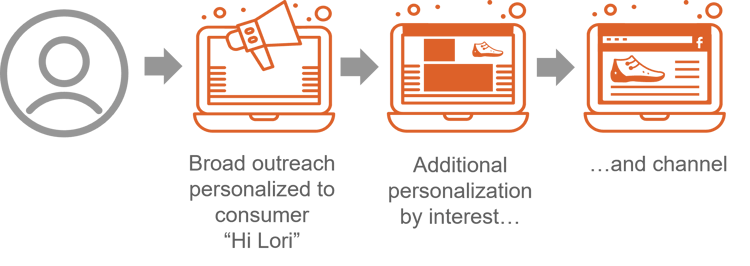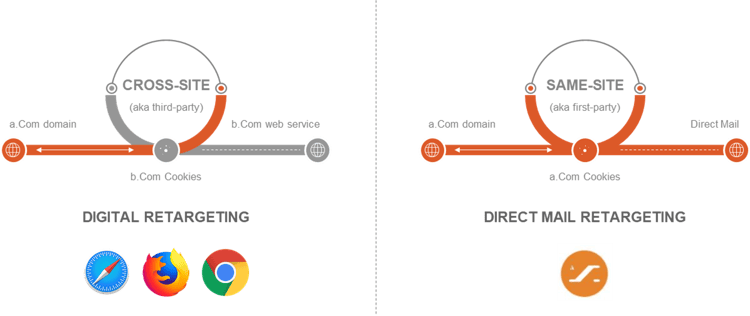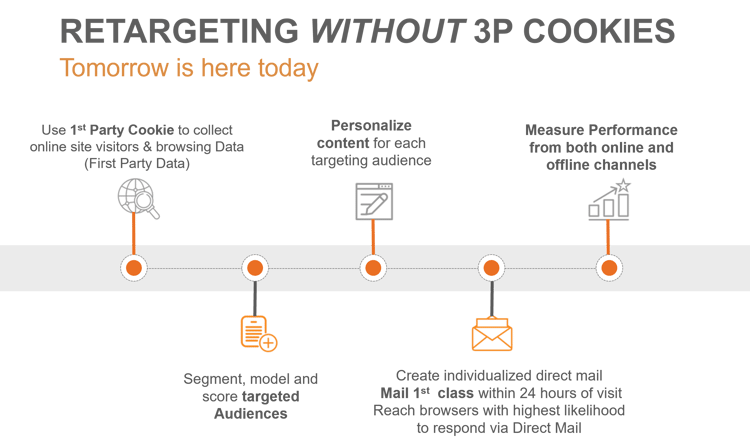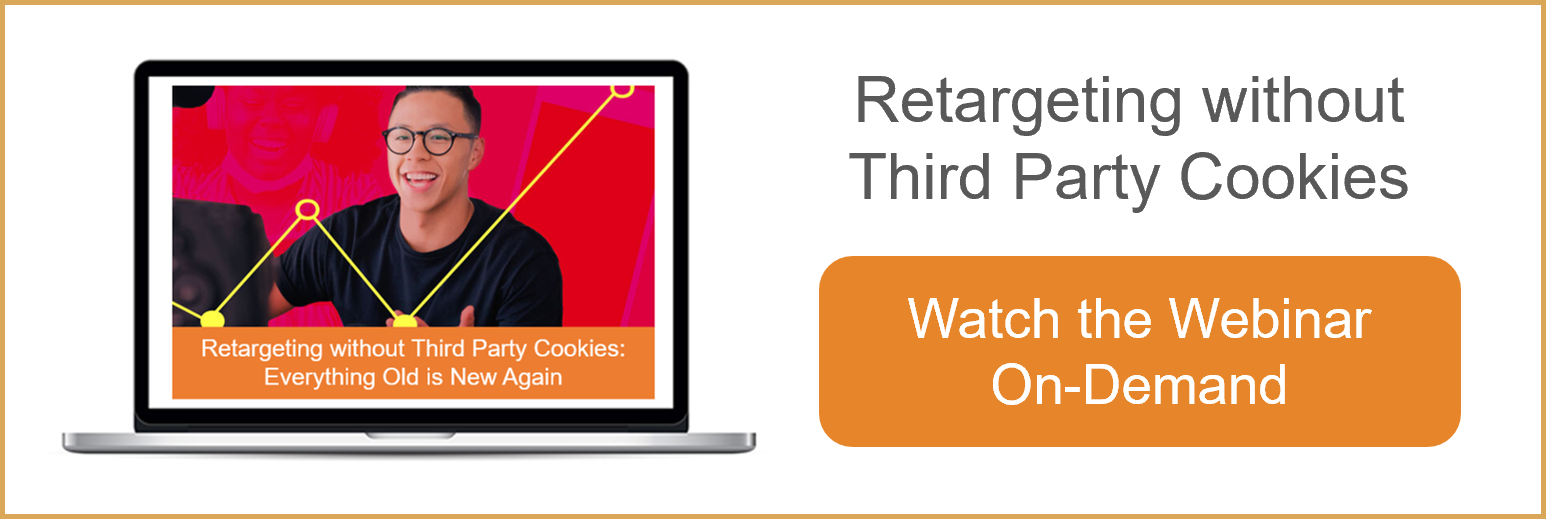
Retargeting is one of the most used strategies in marketing. The ability to remind your customers of your products after they leave your website can be a powerful tool. But, how will the loss of third-party cookies impact this way of marketing?
The Impact of Retargeting Without Third-Party Cookies
Retargeting is the strategy of serving advertisements to customers on external websites based on their previous browsing history on the organization’s website. It's a powerful way to re-engage customers who have previously interacted online with your brand (https://www.thebalancesmb.com/what-is-retargeting-in-marketing-4587536).
When I think of retargeting, I think about four components… audience, content, deliverability and measurement. In this blog, we cover each component of retargeting and how it will be impacted by the impending deprecation of third-party cookies.

Audience
With third-party cookies fading into the background, how is our ability to create audiences impacted?
Some speculate that second-party data is going to make a comeback. Historically, third-party data has been preferred because of scale, but with cookies going away, and increased consumer opt-out of broad data sharing, marketers may be willing to shift to more granular data that drives high response rates.
Benefits of second-party data:
- Sourced through first party cookies and collection
- Easy to manage the ‘chain of opt-in’ and usage
- Enhances a brand’s own data to increase relevancy and scale with segmentation and personalization
And then there is the tried and true, first-party data. First-party data is data passively collected from customers through a brand’s own properties, such as a website or app. Examples of first-party data collection include:
- HTML tracking codes on individual websites
- Behavior information via mobile apps
- Shopping history and product preferences
- Social media accounts
The benefit to first-party data is that customers implicitly provide consent to this type of first-party data collection as they visit and engage with your website. (https://www.mparticle.com/blog/first-party-data-zero-party-data-drive-ltv-growth)
With the departure of third-party cookies marketers will be forced to think a little more about audience formation. How and where do they find the right audiences, and how much do they cost.
Learn more about zero, first, second- and third-party data in our Data Breakdown Infographic.
Content
There is concern that the consumer experience will be severely impacted by this change.
Although, there may be an upside if you are a “Creative”.
Some may consider the content used in retargeting to be uninspiring- creatively speaking. For example, if you looked at a pair of shoes on a website, the retargeting company is likely to build ads with shoes. Perhaps this change in cookies will require marketers to think more strategically about how they interact with customers from a content and messaging perspective.
In terms of personalization, the consumer won't get a generic ad and won't even get an ad personalized to the exact content they were viewing, but they will get personalized content through their preferred channel. The level of personalization that consumers have come to accept is now what they expect.
 There is a fear that content is going to become less personalized due to lack of data availability, either because the consumer opts out of sharing, or because the user can no longer be identified. Ads may shift to be much more targeted based on contextual content vs. user-based data.
There is a fear that content is going to become less personalized due to lack of data availability, either because the consumer opts out of sharing, or because the user can no longer be identified. Ads may shift to be much more targeted based on contextual content vs. user-based data.
There is a belief that browsing the internet will not be as relevant and advertising touchpoints will probably increase as brands try to accommodate for lower response rates through increased impressions.
Deliverability
In terms of potential changes to the deliverability of advertising, marketers should expect that there is going to be a shift back to first-party channels where the user is known (i.e. direct mail).
There is a perception in the market that direct mail is “old school” and expensive, but the response rates still outperform an untargeted display ad in a lot of cases. In fact, email averages a 0.12% response rate, display ads average a response rate of 0.3% while direct mail averages a 4.4% response rate. Check out a channel-by-channel comparison here.
Brands are going to shift to channels that deliver high response rates, with low scale and direct mail is one of the best channels for this.
The economics of direct mail generally tend to prove out the cost side (thus, its survival as a channel still today). So, the market for the direct mail channel expertise should remain vibrant.
Learn more about the Top 10 Advantages of Direct Mail Marketing here.

Measurement
There is more pressure than ever on marketers to prove the value of the campaigns they are running. The third-party cookie provided a unique trail for marketers to follow, allowing for insights into attribution and optimization, what happens to this now?
With increased marketing spend, or even a greater expectation from less marketing spend, we have to be able to measure. And measurement is likely the biggest thing impacted by the loss of third-party cookies.
We are at a fork in the road and there are two distinct options for measurement without third-party cookies.:
- Large content creators/publishers create their own IDs and that results in a lot of walled gardens which means marketers are not able to track results across their spend and measurement becomes an even bigger challenge and consumers aren’t happy because they are getting less relevant (and more frequent) ads that are repetitive across all channels
- Marketers (and consumers) vote with their wallets and demand the industry solve for this in a standardized way. This means a move to standardized IDs like we use with mobile, and it will probably function similar to the 3rd party cookie, but better with more consumer controls.
Marketers and data providers should also be open to the idea that there’s a 3rd or 4th option that hasn’t yet been imagined or emerged. If you like innovation, then that should be exciting, not scary!
I’d like to pull this discussion together by stating that retargeting without third-party cookies is here today and takes advantage of all of the above core components.
- No third-party cookies needed, but rather use your first-party cookie to collect your online site visitors and their browsing data.
- Then segment, model and score for the most targeted audiences.
- Personalize content - with the data consumers shared with you.
- Execute through direct mail within 24 hours of that visit with 95%+ deliverability - and the highest viewability.
- Measure using both online and offline sales data.
It is important to know that there are solutions today for retargeting without the third-party cookie and there will be solutions online as the deadline for third-party cookies approaches.



Lookalike Audiences Enhance customer acquisition by identifying high-potential prospects, boosting response rates, and lowering advertising costs.
Retargeting Postcards Double the performance of your direct mail retargeting.
Amplify Recognize unknown visitors who are actually customers. Add 20-40% to your ESP/CRM campaigns.
IQ Mail Retain customers with personalized, timely messages for those opting out of digital channels.










Comments